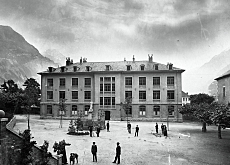
School marks lessons learned over 200 years

The College of Saint-Maurice, a secondary school in southern Switzerland where Interior Minister Pascal Couchepin once studied, is celebrating its bicentennial.
The famous school, with close ties to the nearby Abbey of Saint-Maurice, places great importance on putting the individual at the centre of its concerns.
“For us the student is first and foremost a person, not a number,” explained head teacher Yves Fournier. “We don’t put students on a pedestal, but we try to discover their abilities so that they can get as much out of the teaching as possible.”
At a time when teaching methods are being criticised in Switzerland, the College of Saint-Maurice, squeezed between the mountains and the River Rhone, takes things in its stride.
The school’s history is closely linked to the abbey, and has pursued the teaching tradition initiated by the cloister’s canons. The institution’s motto is “tradition and dynamism”, and when its director, Guy Luisier, gave a speech on the school’s 200th birthday, the word “roots” stood out.
“Our Christian, human and humanistic roots, as well as our traditions of opposition and non-conformism in the face of social and cultural fads allow us to see clearly far ahead,” he wrote.
Legends
The list of former students includes politicians such as the interior minister, and Switzerland’s world skating champion Stéphane Lambiel.
The school’s emphasis on the arts has also had a profound influence on generations of Swiss writers, such as Maurice Chappaz, Georges Borgeaud, and Noelle Revaz.
“The quality of the education was very high, but the idea of separating boys from girls was ridiculous,” said journalist and former student François Gross, who was once severely reprimanded for sneaking out to see a girl.
Up until the end of the 1960s, the school represented part of the French-speaking Catholic counter-culture. Like Fribourg University, it was a refuge for students from well-off Catholic families who wanted to shield their sons from liberal influences.
Although the college failed to withstand the winds of change in the 1970s – the arrival of girls as well as the introduction of sciences and business studies – it remains a stronghold of certain values to this day.
Preparation
Anyone wishing to join the Aguauna, the society of former students, for example no longer has to be a member of the centre-right Christian Democratic Party and a practising Catholic. However, according to the statutes, the applicant still has to be “a believer and hold Christian values”.
“Many of our boarding students are from upper-middle-class families who want to be sure that their children don’t fall into the hands of anti-establishment teachers,” said a former student, who added that Saint Maurice provides both an excellent education and an ideological straightjacket.
Fournier would rather focus on the tradition of excellence. “Academic standards should not be played down. Obviously some people might feel that they are a burden, but others benefit widely from the experience which prepares them for the rest of their student lives,” he argued.
And, the writer Maurice Chappaz admitted receiving a lesson he would never forget: “They used to tell us that there were only two vocations in life – becoming a great writer of religious texts and becoming an artist.”
swissinfo, Carole Wälti
The story of the College de Saint-Maurice is linked to that of the Abbey of Saint-Maurice d’Agaune. Built 15 centuries ago in memory of martyrs, the abbey used to comprise a monastery school.
The modern-day school was established at the start of the 19th century and became a semi-private boarding school run by canons under state supervision.
Until the end of the Second World War, the classes were fixed according to the daily lives of the clergy. Teaching was based on classical educational values that ignored the sciences and modern languages.
In 1969 the first girls were allowed to study at the school.
The college now has 1,150 students, 90% of whom are from canton Valais. Students are aged 14 to 20, and 52% are girls.
Approximately 100 teachers work at Saint-Maurice, including five canons. But the number of religious teachers is in constant decline.

In compliance with the JTI standards
More: SWI swissinfo.ch certified by the Journalism Trust Initiative

















![The four-metre-long painting "Sonntag der Bergbauern" [Sunday of the Mountain Farmers, 1923-24/26] had to be removed by a crane from the German Chancellery in Berlin for the exhibition in Bern.](https://www.swissinfo.ch/content/wp-content/uploads/sites/13/2025/12/01_Pressebild_KirchnerxKirchner.jpg?ver=8f77363a)











You can find an overview of ongoing debates with our journalists here . Please join us!
If you want to start a conversation about a topic raised in this article or want to report factual errors, email us at english@swissinfo.ch.